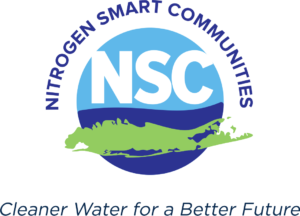
In response to Long Island’s nitrogen pollution problem, the Long Island Nitrogen Action Plan (LINAP) was launched in 2016. LINAP is a multiyear initiative to reduce the amount of nitrogen entering Long Island’s groundwater and surface water from wastewater (sewer and septic systems), stormwater runoff, and fertilizers. LINAP is led by the New York State Department of Environmental Conservation (DEC) and the Long Island Regional Planning Council (LIRPC), along with Suffolk and Nassau counties, and with input from multiple partners and stakeholders.
Nitrogen is the leading cause of water quality deterioration in Long Island’s estuaries. Excess nitrogen can cause toxic algal blooms that lead to low oxygen conditions, fish kills, and degraded wetlands and marine habitats. Nitrogen also contaminates the groundwater which is the sole source of Long Island’s drinking water.
DEC and LIRPC have developed a program called Nitrogen Smart Communities (NSC) as part of the Long Island Nitrogen Action Plan initiative. The program encourages municipalities in Nassau and Suffolk counties to take meaningful and effective actions to reduce, prevent or eliminate nitrogen pollution in Long Island’s waters through a coordinated, community-specific plan of action.
Nitrogen Smart Communities Program Overview
Nitrogen Smart Communities (NSC) is a voluntary program created by LINAP to promote local action and awareness to reduce and/or eliminate nitrogen from all sources within municipalities on Long Island.
This can be achieved by better understanding a community’s unique sources of nitrogen and committing to implementing reduction activities associated with those priorities. By participating in the Nitrogen Smart Communities program, a community can reduce nitrogen pollution in degraded waterbodies and protect areas before impairments occur. Participating municipalities will follow a series of steps and submit completed worksheets to earn tiered levels of Nitrogen Smart Communities status certification (Bronze, Silver, Gold).
To read the full NSC program overview, click here.
Program Guide
This document will guide the municipality through the Steps and Actions of the NSC program.
Each section will provide detailed instructions and information needed to complete the associated Steps and Worksheets.
To read the full NSC program guide click here.
Resources



